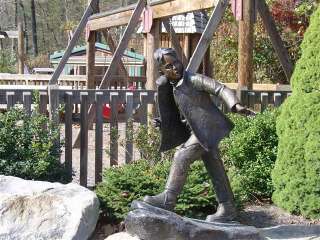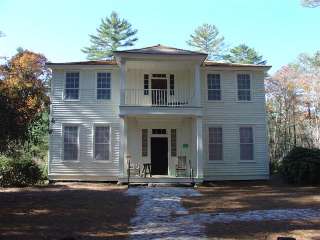
Cashiers - Highlands - Sapphire
CASHIERS, pronounced cash'ers, NORTH CAROLINA
As the last Ice Age slowly retreated from the North American continent, the oldest mountain range in the world, the Appalachians, revealed itself. Ice-carved mountain valleys appeared and became the Cashiers area which straddles the Blue Ridge and the Eastern Continental Divide.
The Cashiers area was in Indian Territory and in the winter, the area was a hunting ground.
By the early 1820's, settlers began arriving from South Carolina, using the Indian and buffalo trails. Word of the natural wonders of the mountains quickly spread and, in the 1890's entrepreneurs from both the North and South visited Cashiers in the summer.
Today, families from all over the world make the summer migration to these mountains and claim the Appalachians for themselves.
Zachary Tolbert House
Thomas and Wendy Dowden purchased the Zachery-Tolbert house in 1997, and after initial feasibility studies and fund raising, the Dowdens donated the house and adjacent property to the Cashiers Historical Society, an affiliate of the Village Conservancy. The Society then began an extensive restoration project executed by Lupoli Construction of Highlands under the guidance of Harris Architects of Brevard. Now on the National Register, the Zachary-Tolbert House is open for special tours and events. Programs have been developed for local school children at the site. Restoration efforts continue with plans for the kitchen building and further development of the site.
History of Wolf Mountain, Panthertown Valley
Man recounts history of Wolf Mountain, Panthertown Valley
By Bill Milliken as told to Jim Milliken For the Chronicle Posted: Tuesday, Dec 21, 2004 - 04:57:06 pm EST
Author's note: Dates and times may not be exact, but this is a general narrative of this era.
This is a story of the 20th century history of Panthertown Valley as told by Bill Milliken, who is probably the only person living who's still familiar with what happened 50 years ago. This area called Panthertown Valley is the headwaters of the Tuckaseigee River and the watershed that flows north from the Eastern Continental Divide. It lies under Toxaway Mountain, which is on that Divide. These headwaters are comprised of two forks of the Panthertown Creek: Greenland Creek, and Green Creek. The old local residents always refer to this area as "Painter Town" in their references. It is very pristine and has not been used much until recent years. Interestingly enough, there are remnants of one old settler's cabin, identified by rocks from an old chimney and one old apple tree in the corner of about two acres that was cleared up. A woman's shoe, worn in the early 1800s, was also found near the old chimney. It was located at the key location in Panthertown Valley. Basically, the area was made up of several ownerships, probably comprised of a total of about 5,000 to 6,000 acres. It was quite inaccessible until in the 20s or 30s when a "Little Donkey" railroad was set up to run into this valley from the Lake Toxaway side on the east through Cold Mountain Gap. It was togged by the Moltz Lumber Company at Lake Toxaway. Following the Continental Divide around, under Toxaway Mountain Fire Tower, this land was adjoined to the west and north by lands of the Old Wolf Mountain Lumber Company, who owned several thousand acres in this area. Some of the ownerships that were there were the Asheville owners of Wolf Mountain Lumber Company land, Moltz property, Botts property, Albert Moss property and several small 50- to 100-acre properties. That basically is the property that we're speaking of, now owned by the U.S. Forest Service referred to as "Panthertown." The principal players in this narrative were the Liberty Life Insurance Company, headed by Francis Hipp, who was president, and key employees of Liberty Life Insurance Company. The next principal involved was James McClure Clarke, known as "Jamie" Clarke from Asheville. He was agent for a group of Asheville owners who owned the Wolf Mountain Lumber Company land of some 12,000 acres. William F. (Bill) Milliken, who is narrating this, was the next principal1 involved. He owned Milliken Forestry Company, a consulting forestry firm, in Columbia, S.C., and was helped throughout the early days by Mac Lupold, who was a member of his staff. Final key people involved in this operation were Herbert and Herman Nicholson and Herbert's wife, Dot, who lived on the property and were the day-to-day caretakers. Liberty did the financing and the legal work necessary to put together the properties. Milliken handled all the fieldwork involved in the planning, along with Mac Lupold, his assistant, in putting the lands together. All of the groundwork in the field was done by Herbert Nicholson, Mac Lupold and Bill Milliken. This started out in the late 50s and early 60s of the 20th century. Liberty was looking around for the possibility of investing some of their investment portfolio in timberland. When they found out that the Asheville interest had some 12,000 acres of land in North Carolina that they wished to possibly sell, they became interested. The result was that Liberty Life ended up buying an undivided 50 percent interest in the Wolf Mountain land. At that point it became necessary to locate the properties in the field and check out plats, etc. They found that there were many adverse holdings within the Wolf Mountain lands, so Liberty set about to buy them. First they bought an undivided 50 percent interest in the Wolf Mountain lands. Then the property was actually divided on the ground. Then an active effort was made by Liberty and Milliken to purchase the adverse holdings, principally the Moltz, Moss and Botts properties, totaling a couple of thousand acres. They then purchased the remaining 50 percent of Wolf Mountain. When they were able to purchase these properties, they kept right on until they had all the adverse holdings over about a 15-year period, taking them up to the late 70s. When it was all through, they had approximately 14,000 acres put together, of which the headwaters of the Tuckaseigee River, known as Panthertown, was right in the middle. Then there became a period in the 70s when they felt like it was time for them to recoup some of their investment, and they blocked off several perimeter areas in the vicinity of Lake Toxaway on the east and Laurel Knob and Big Ridge on the west. These were appendages that stuck out and did not fit into the long-range plans, so they recouped some of their investment by sales of these properties, reducing the 14,000 acres back to some 8,000 acres. As mentioned before, they purchased the last undivided 50 percent interest from the Ashevil1e group, but Jamie Clarke from Asheville, who was the agent of that ownership as well as part owner, had reserved 100 plus or minus acres when the last 50 percent undivided interest was bought by Liberty. This is at the very northern end of the Wolf Mountain property. To this day they still maintain the old clubhouse on the Tuckaseigee River. Soon after, Clarke was elected to the U.S. Congress for the Western North Carolina District. Also, at this point in time, the U.S. Forest Service, which had a good bit of land in that country, had shown an interest in purchasing some of the property. At the same time all this was going on, the area had been discovered by the people from Florida, in particular, and there were more and more people wanting more and more property up in that area. Liberty sold off some 6,000 acres, as previously mentioned, and most of that land was developed into prime development property up on top of the Blue Ridge and the creeks that ran off from it. Liberty had plans to find the right person to make a major development in the Panthertown country. Milliken had made a Land Use Plan in which there were lakes, golf courses, ski slopes, and home sites, etc. The one thing missing was access to the west to the Town of Cashiers, which would be the nearest town of any kind. Liberty made trails from logging roads, built bridges and planted trees. They purchased a right-of-way through mostly property owned by Breedlove, from the end of the Breedlove Road into the Wolf Mountain properties. Milliken, Lupold and Nicholson proceeded to lay out a road off the top of the Divide down into the end of Old Breedlove Road. That opened up the accessibility of the property on the west side going into Cashiers, which made the property more valuable for possible development. Lake Toxaway had been fully developed by that time and continues to develop on the east. Sapphire Valley and Sapphire Lakes and Bald Rock have been developed to the south. High Hemlock has been developed to the west, with very little development to the north because of accessibility. Liberty sold "High Hemlock," which they had started. They then did a small development called "Glen Ridge" at Double Knobb Gap on the Blue Ridge Divide for its employees and friends and where Milliken built his home, "Sylva Mons" (Latin for Forest Mountain). Beautiful Laurel Knob was included. Francis Hipp died and was succeeded by his son, Hayne Hipp, who owns a home site overlooking some of the property. The Nicholsons, except Dot, had died. In the 80s, the U.S. Park Service laid out on paper and tried to extend the Blue Ridge Parkway to include Panthertown Valley as a rest stop on the proposed route. It never materialized. Liberty Properties decided to sell the remaining acres to Duke Power Company, who had made them an offer. It turned out Duke had purchased Nantahala Power Company in North Carolina and had bought the area now known as Keowee/Toxaway on the Toxaway River in South Carolina to build a large nuclear power lake known as Keowee/Toxaway. They wished to connect their power grid at Lake Glenville in North Carolina to the south, through part of Panthertown, to their South Carolina grid. They then proceeded to build a power tine, well camouflaged and well done, across the total 9,000 plus or minus acres that they had purchased from Liberty Properties. This was some 30 plus or minus miles. When they had completed the line, they then sold the entire acreage to the Nature Conservancy with the idea of turning this area over to the U.S. Forest Service to be used for public recreation. This is a very unique piece of property because of its high location of 3,500 to 5,000 feet in elevation. It also includes the headwaters of the Tuckaseigee River with its pure native brook trout, miles upon miles of hiking, rare and spectacular vistas and overlooks, eight beautiful waterfalls, sheer rock cliffs and two small mountains sticking up in the middle of the valley. One was called Big Green Mountain, and one was called Little Green Mountain. The rock faces were burned clear in a big forest fire in the 1920s after the logging had taken place of the large white pine and hemlock some 80 years ago. Because of the rock cliffs, caves and cracks in the rock cliffs, this property has probably a little more than its share of snakes. It has been called a miniature Yosemite of the east, referring to Yosemite National Park in California. This is with good cause. It is so spectacular in its views that the public has begun to use the property more than expected. It's necessary that more trails be opened up to spread the use of the property out because most people want to walk just in the pristine val1eys. Trails need to be used out on the extremities more to the north. Bill Milliken, who is telling this story, has retired and is trying to recover from three strokes in the past few years. He's unable to visit or use the home that he built up at Double Knobb Gap going into the valley. His daughter, Susan Umbach, and his son, Jim Milliken, still go to Sylva Mons at the Glen Ridge development and timeshare with friends. Jim knows Panthertown as good or better than any living person, and he still takes people on hikes through the area. Over 40 years have passed with much water passing over the many waterfalls. I wish to dedicate this narrative to my dear visionary friend, Francis Hipp, whose cooperation and thinking helped me to carry out our plans and made our work worthwhile. Many people at Liberty Corporation then were involved, and I spent endless days and nights at Herbert and Dot's home, in all four seasons of the year, and worked in all weather. Many locals became dear friends. Liberty and I can be proud of what we put together and developed for posterity. Duke got what they needed, Jamie Clarke and the public have what is a public legacy, and Nancy, my wife, and I have 40 years of marvelous memories. I'm glad I've been blessed by God to record this little episode of yesterday.
Call The Carolina Cone Team
Alan ~ 828-507-1522; Tina ~ 828-507-5777
E Mail The Carolina Cone Team [email protected]



